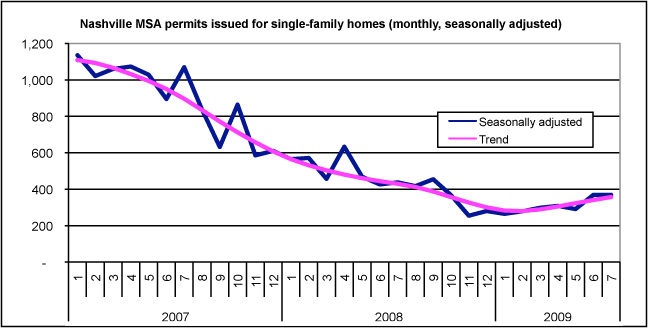Second Quarter Not as Bad as the First
Perhaps the only good thing about the second quarter for the middle Tennessee economy is that it was not as bad as the first quarter. Faint praise indeed, given the difficult economic conditions we experienced in the first quarter. In all, economic activity continued to decline at a slower pace, with one notable exception: housing construction appears to have finally turned the corner.
The more comprehensive indicators of economic activity, however, continue to signal contraction (Table 1). More jobs were lost, with total employment dropping to its lowest level since the second quarter of 2005. The unemployment rate rose to 10.3 percent in the midstate and 9.4 percent for the Nashville metropolitan area, but the increase was somewhat lower than in the first quarter. An encouraging sign is found in initial claims for unemployment insurance, which fell to an average of 13,770 per week. Initial claims peaked during the first quarter and now appear to be on the decline. The level of initial claims, however, remains very high by historical standards and almost double that of a year ago. By contrast, continued unemployment insurance claims rose substantially, suggesting little relief for unemployment rates in the near future.
Job losses in the goods-producing sectors of construction and manufacturing accelerated in the Nashville MSA, with construction employment down 4.2 percent and manufacturing down 3.9 percent from the previous quarter (Table 2). Job gains seem to be distant for these two sectors, although the losses should become less severe in the coming months for two reasons. First, as mentioned earlier, housing construction is showing improvement as more permits are being issued for construction of single-family homes (see figure below).

But a building permit essentially indicates an intention to build; the economic impact will not be felt until construction gets underway. Second, manufacturing in the United States is moving much closer to a neutral stance. The PMI (Purchasing Managers Index), a well-known indicator of manufacturing activity, moved very close to neutral following 18 months of negative territory. This means that manufacturing is closing in on the time when output is rising instead of declining. This is good news for the manufacturing-heavy midstate economy, where a large percentage of total payrolls depends on manufacturing.
Midstate households offer little evidence that consumer spending will lead the way to recovery, as household spending continued to plummet in the second quarter. Taxable sales plunged 3.8 percent in the Nashville MSA and 3.3 percent in the midstate area, offering no evidence at all that consumers are beginning to spend again. The cash-for-clunkers incentive will show some impact on July and August sales tax collections, but the effect will very likely be temporary. It is difficult to imagine a scenario in which consumer spending leads the midstate to recovery in the absence of job growth. In coming months, however, housing construction should shift from a drag on tax collections to a positive contribution.
Unemployment continues to rise in the Chattanooga and Clarksville metropolitan areas, reaching 9.3 percent and 10.2 percent in the second quarter, respectively (Table 3). Loss of nonfarm employment accelerated in the second quarter for Chattanooga, with a decline of 1.4 percent from the first quarter, while Clarksville lost just 0.5 percent.
Taxable sales dropped in both areas, with Chattanooga experiencing a somewhat larger decline. While taxable spending is falling, the rate of decline is much less than for the midstate and Nashville areas.
Housing construction activity, as measured by permits issued for single-family homes, rose in Chattanooga but declined in Clarksville. The decline for Clarksville is not unexpected given the very large increase in the first quarter.